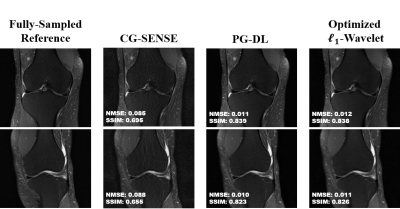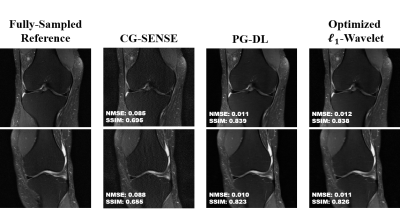Hongyi Gu1,2, Burhaneddin Yaman2,3, Kamil Ugurbil2, Steen Moeller2, and Mehmet Akcakaya2,3
1Electrical Engineering, University of Minnesota, Minneapolis, MN, United States, 2Center for magnetic resonance research, Minneapolis, MN, United States, 3University of Minnesota, Minneapolis, MN, United States
1Electrical Engineering, University of Minnesota, Minneapolis, MN, United States, 2Center for magnetic resonance research, Minneapolis, MN, United States, 3University of Minnesota, Minneapolis, MN, United States
An optimized l1-wavelet compressed sensing method achieves
comparable reconstruction quality to physics-guided deep learning, while using
much fewer parameters and a linear representation amenable to interpretation.

Figure 1. Schematic
of the unrolled ADMM for $$$\ell_{1}$$$-wavelet compressed
sensing (CS). One unrolled iteration of ADMM with
$$$\ell_{1}$$$-wavelet regularizers consists
of regularizer (R), data consistency (DC) and dual update (DWT: Discrete
wavelet transform). For T = 10 iterations, this leads to a total of 116
trainable parameters, as dual update is not needed for the last iteration.
